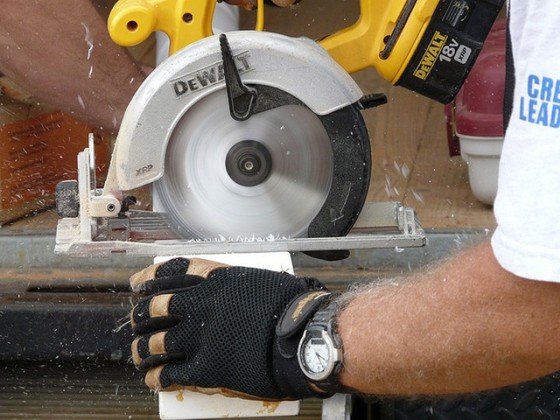

We may earn revenue from the products available on this page and participate in affiliate programs. Learn More ›
Despite its name, the portable circular saw (or any circular saw, for that matter) cuts only straight lines. The name actually refers to the shape of its blade. To put it to use safely and effectively, follow this procedure.
Set the depth of cut. First, adjust the distance the blade protrudes from the sole of the saw. The saw should cut only slightly (perhaps a quarter inch) through the workpiece, for reasons of both safety and efficiency.
Cut with the good side down. The blade in a circular saw rotates so that the teeth come from the lower side and cut up into the workpiece, which means that any splintering that occurs will be on the top of the piece. Thus, on finish work, you should mark the back of the piece to be cut: That way, the good side will show and have the smoother edge.
Align with the line. Position the workpiece on a sawhorse or a stable work surface. Now, rest the front of the saw base on the workpiece, aligning the cutting guide at the front of the sole with the line to be cut. Crosscutting is difficult to do accurately, so use a guide like a speed square or combination square to insure a straight cut.
When preparing to cut, bring the saw to full speed before bringing the blade in contact with the wood. Advance the saw smoothly: If you push too hard, the blade may jam (if it does, back off slightly, then advance again at a more measured rate). The sound the saw makes is your best indication of a proper pace.
Making an angle cut. To cut on an angle, the adjustable sole of the circular saw is shifted to the desired pitch. The depth of cut may need to be adjusted as well.
Pocket cuts. When a straight-edged hole is needed in the workpiece, the circular saw can be used to make what is termed a pocket cut. Adjust the depth of cut so that the saw will cut no more than a quarter inch beyond the thickness of the wood. Angle the saw on the toe of its shoe immediately above a line to be cut.
Power up to full speed, then gradually lower the saw. Wait until its sole is flush to the surface of the material being cut before advancing the saw. Repeat the procedure for each line to be cut; a handsaw or saber saw will be required to clean out the waste from the corners.
And don’t forget: Wear your protective equipment, plan your cuts carefully, position the workpiece with care, and most importantly, be conscious of your safety at every step.
